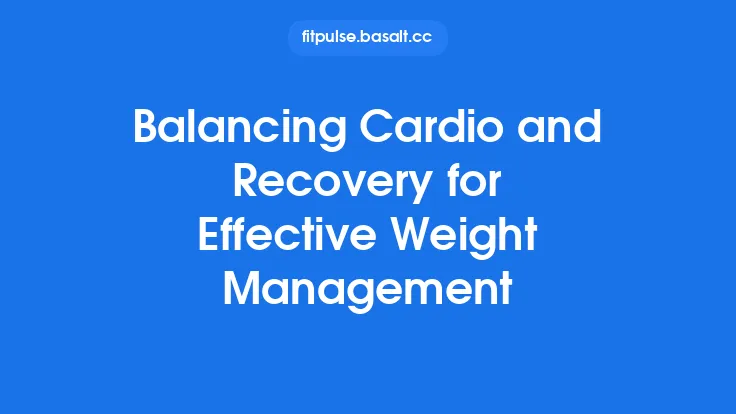Balancing the calories you consume with the calories you burn is the cornerstone of any lasting fitness journey. While the concept of “calories in vs. calories out” sounds simple, the reality is a dynamic interplay of physiology, behavior, and training variables. Understanding how to fine‑tune this balance enables you to make steady progress—whether your goal is to shed excess body fat, build lean muscle, or simply maintain a healthy weight—without the roller‑coaster of rapid weight swings, metabolic slowdown, or burnout.
Understanding Energy Balance
Energy balance is the net result of two opposing forces:
- Energy Intake (EI) – the total caloric content of everything you ingest, including foods, beverages, and any caloric additives.
- Energy Expenditure (EE) – the total calories your body uses to sustain life and activity.
When EI = EE, body weight remains stable. When EI > EE, the surplus is stored primarily as adipose tissue, leading to weight gain. Conversely, when EI < EE, the deficit forces the body to tap into stored energy, resulting in weight loss.
The key to sustainable fitness progress lies in managing the magnitude and duration of any imbalance. Small, consistent adjustments tend to produce more reliable, long‑term results than drastic swings that trigger metabolic adaptations and psychological fatigue.
The Components of Energy Expenditure
Energy expenditure is not a single number; it comprises several distinct components that together determine your daily caloric burn.
| Component | Description | Typical Contribution |
|---|---|---|
| Basal Metabolic Rate (BMR) | Calories required to maintain vital functions (breathing, circulation, cellular metabolism) at rest. | 60–75 % of total EE |
| Thermic Effect of Food (TEF) | Energy used to digest, absorb, and metabolize nutrients. | 5–10 % of total EE |
| Non‑Exercise Activity Thermogenesis (NEAT) | Calories expended through everyday movements (fidgeting, walking to the kitchen, standing). | 5–15 % of total EE (highly variable) |
| Exercise Activity Thermogenesis (EAT) | Calories burned during structured workouts (resistance training, cardio, sport). | 5–30 % of total EE (depends on training volume) |
| Adaptive Thermogenesis | Adjustments in heat production in response to environmental or metabolic changes (e.g., cold exposure, overfeeding). | Variable, often modest |
Understanding each component helps you identify where you can make realistic adjustments. For most individuals, NEAT and EAT are the most accessible levers for increasing EE without compromising recovery or overall health.
Calculating Your Personal Energy Needs
1. Estimate Basal Metabolic Rate
Several validated equations exist; the Mifflin‑St Jeor formula is widely used for its accuracy across populations:
- Men: BMR = 10 × weight (kg) + 6.25 × height (cm) – 5 × age (yr) + 5
- Women: BMR = 10 × weight (kg) + 6.25 × height (cm) – 5 × age (yr) – 161
2. Apply an Activity Factor
Multiply BMR by a factor that reflects your overall activity level (including NEAT and structured exercise):
| Activity Level | Factor |
|---|---|
| Sedentary (little or no exercise) | 1.2 |
| Lightly active (light exercise 1–3 days/week) | 1.375 |
| Moderately active (moderate exercise 3–5 days/week) | 1.55 |
| Very active (hard exercise 6–7 days/week) | 1.725 |
| Extremely active (very hard training, physical job) | 1.9 |
The product yields your Total Daily Energy Expenditure (TDEE)—the baseline number you need to maintain current weight.
3. Adjust for Goals
- Weight loss: Subtract 10–20 % of TDEE (≈ 200–500 kcal) to create a moderate deficit. Larger deficits accelerate loss but increase the risk of muscle loss and metabolic slowdown.
- Weight gain (lean mass): Add 5–10 % of TDEE (≈ 150–300 kcal) to support tissue synthesis while minimizing excess fat gain.
- Maintenance: Keep intake within ± 5 % of TDEE to allow for day‑to‑day fluctuations.
Strategies for Adjusting Energy Intake
1. Portion Control and Energy Density
- Energy density refers to calories per gram of food. Low‑density foods (vegetables, fruits, broth‑based soups) provide volume and satiety with fewer calories, making it easier to stay within a target range.
- Use visual cues (hand‑size portions, plate method) or measuring tools to keep servings consistent.
2. Meal Frequency and Distribution
While the timing of meals is outside the scope of this article, the overall distribution of calories across the day can influence hunger and adherence. Some individuals find that spreading intake over 3–5 meals reduces cravings, whereas others thrive on fewer, larger meals. Choose the pattern that aligns with your lifestyle and satiety signals.
3. Mindful Eating Practices
- Slow down: Chewing thoroughly and pausing between bites allows physiological satiety signals to catch up.
- Eliminate distractions: Eating while watching screens can lead to inadvertent overconsumption.
- Hunger vs. habit: Distinguish true physiological hunger from emotional or situational cues.
4. Tracking and Feedback
- Food logs (paper or digital) provide objective data on intake. Even a brief daily record improves awareness and accuracy.
- Periodic reviews (weekly or bi‑weekly) help you spot trends, adjust portions, and stay aligned with your target deficit or surplus.
Sustainable Approaches to Caloric Deficit or Surplus
Gradual Adjustments
- Deficit: Aim for a 250–500 kcal/day reduction. This typically yields 0.5–1 lb (0.2–0.45 kg) of weight loss per week—slow enough to preserve lean mass and minimize metabolic adaptation.
- Surplus: Incrementally increase intake by 100–200 kcal/week. This allows the body to adapt, supporting muscle accretion while limiting unnecessary fat gain.
Re‑Evaluation Cycles
Every 4–6 weeks, reassess:
- Body composition: Use reliable methods (dual‑energy X‑ray absorptiometry, bioelectrical impedance with consistent protocols, or skinfold measurements) to gauge changes.
- Performance metrics: Strength, endurance, and recovery markers indicate whether energy intake supports training demands.
- Subjective wellbeing: Mood, sleep quality, and hunger levels provide early signals of over‑ or under‑fueling.
If progress stalls, adjust intake by 5–10 % and monitor the response.
Monitoring Body Composition, Not Just the Scale
Weight alone is a blunt instrument. Two individuals with identical body weight can have vastly different body fat percentages and muscle mass. Sustainable fitness progress is better tracked through:
- Body fat percentage: Provides insight into the quality of weight change.
- Circumference measurements: Waist, hips, thighs, and arms reflect regional changes.
- Progress photos: Visual documentation captures subtle shifts that numbers may miss.
By focusing on composition, you can maintain motivation even when the scale fluctuates due to water balance or glycogen stores.
Psychological and Behavioral Considerations
1. Goal Setting
- SMART goals (Specific, Measurable, Achievable, Relevant, Time‑bound) create clear milestones.
- Break long‑term objectives into short, actionable steps (e.g., “reduce daily intake by 150 kcal for the next two weeks”).
2. Habit Stacking
Link a new nutrition habit to an existing routine (e.g., “prepare a vegetable‑rich side dish while the coffee brews”). This leverages existing neural pathways, making the new behavior easier to sustain.
3. Flexibility and “Refeeds”
Occasional higher‑calorie days (often called “refeeds”) can provide psychological relief and temporarily boost leptin levels, which may help mitigate metabolic slowdown. The key is to keep these days structured and not let them become unrestricted eating episodes.
4. Social Support
Sharing goals with friends, family, or a community (online forums, workout groups) creates accountability and reduces the sense of isolation that can accompany dietary changes.
Common Pitfalls and How to Avoid Them
| Pitfall | Why It Happens | Countermeasure |
|---|---|---|
| Over‑estimating activity calories | Wearable devices can over‑report EE, especially during low‑intensity activities. | Use a conservative estimate; cross‑check with heart‑rate‑based calculations. |
| Undereating for rapid results | Desire for quick weight loss leads to aggressive deficits. | Stick to ≤ 20 % deficit; prioritize protein and nutrient density to preserve muscle. |
| Neglecting NEAT | Focus on structured workouts while ignoring daily movement. | Incorporate standing desks, short walking breaks, and purposeful chores. |
| Relying solely on the scale | Water shifts and glycogen fluctuations mask true progress. | Pair weight tracking with body composition measures and performance logs. |
| All‑or‑nothing mindset | One “cheat” meal triggers a belief that the entire plan is ruined. | Adopt a flexible approach; view occasional indulgences as part of a balanced plan. |
Integrating Energy Balance with Training Programming
Periodization and Energy Needs
- Hypertrophy phases (higher volume, moderate intensity) often benefit from a slight caloric surplus to support muscle protein synthesis.
- Strength/power phases (lower volume, high intensity) may be maintained at maintenance calories to preserve lean mass while optimizing neural adaptations.
- Endurance or cutting phases (higher volume, lower intensity) typically align with a modest deficit, ensuring sufficient fuel for prolonged sessions.
Adjust your intake in tandem with the training block, rather than treating nutrition as a static backdrop.
Recovery Considerations
Even without delving into specific macronutrient timing, it’s essential to recognize that adequate overall energy availability underpins recovery processes such as:
- Glycogen replenishment (requires sufficient calories)
- Hormonal balance (e.g., cortisol, testosterone)
- Immune function (energy‑dependent)
If you notice persistent fatigue, decreased performance, or frequent illness, reassess whether your energy intake matches the cumulative demands of training and daily life.
Practical Tools and Resources
- Online calculators (Mifflin‑St Jeor, Harris‑Benedict) for quick BMR/TDEE estimates.
- Food tracking apps (MyFitnessPal, Cronometer) that provide calorie counts and basic nutrient breakdowns.
- Wearable activity monitors (Fitbit, Apple Watch) for estimating EE—use as a guide, not an absolute.
- Body composition devices (handheld BIA, smart scales) for trend monitoring—ensure consistent testing conditions.
- Spreadsheet templates for logging intake, EE, and progress metrics—customizable to personal preferences.
Closing Thoughts
Balancing energy intake and expenditure is a dynamic, lifelong skill rather than a one‑time calculation. By grounding your approach in accurate assessments, modest and sustainable adjustments, and a keen awareness of behavioral factors, you create a resilient foundation for fitness progress. Remember that the goal is not merely to tip the caloric scales temporarily, but to cultivate a harmonious relationship between what you eat, how you move, and how you feel—ensuring that every step forward is both measurable and maintainable.




